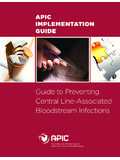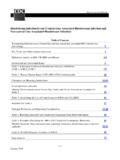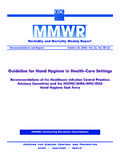Transcription of Preventing central line-associated bloodstream …
1 Preventing central line - associated bloodstream infections: The CLABSI Bundle 1. Do central Lines Cause bloodstream Infections? central venous catheters (CVCs) disrupt the integrity of the skin, making infection with bacteria and/or fungi possible. Infection may spread to the bloodstream and hemodynamic changes and organ dysfunction (severe sepsis) may ensue. Approximately 90% of the catheter-related bloodstream infections (BSIs) occur with CVCs. Maki DG. Infections due to infusion therapy. In: Hospital Infections, Third Edition, Bennett JV, Brachman PS (eds), Little, Brown, Boston 1992.
2 Incidence and Risk 48% of ICU patients have central venous catheters, accounting for 15. million central venous catheter-days per year in ICUs. The case fatality rate for catheter- related bloodstream infections approaches 20%. Mermel LA. Ann Int Med. 2000;132: 391-402. Soufir L et al. Infect Control Hosp Epidemiol. 1999 Jun;20(6):396-401. central line associated BSI's (CLABSI) are Costly & Prolong Care ! Attributable cost per bloodstream infection is estimated to be $3,700 to $29,000. ! HAI bloodstream infections prolong hospitalisation by a mean of 7 days.
3 Pittet D, Tarara D, Wenzel RP. JAMA. May 25 1994;271(20):1598-1601. Soufir L et al. Infect Control Hosp Epidemiol 1999 Jun;20(6):396-401. CLABSI Risk Factors Risk Factors with Percutaneous Non- Tunneled Catheters: Site of insertion: Subclavian vein less risky than internal jugular or femoral vein Multiple ports/hubs: More manipulation and contamination Parenteral feeding: TPN and/or lipids Infection elsewhere: Remote, , UTI or wound Mermel LA, Am J Med. Sep 16 1991;91(3B):197S-205S. McCarthy MC, J Parenter Enteral Nutr 1987; 11:259.
4 Evidence Summary Attributable mortality is 4-20%. Routine replacement does not reduce risk Maximal barrier precautions reduce risk CVCs coated with antiseptics or antibiotics may reduce risk but are expensive Use of chlorhexidine skin prep reduces risk more than povidone-iodine Saint S. #ptsafety Opportunity Knocks What if a series of interventions could markedly reduce the risk of CLABSI? What if those interventions were already readily available in hospitals? What if all of those interventions were done all of the time on each patient?
5 Benefits of Reducing CLABSI. Better patient outcomes Reduced mortality Improved satisfaction Nursing Physician Patients and families Financial benefits The central line Bundle is a group of interventions related to patients with intravascular central catheters that, when implemented together, result in better outcomes than when implemented individually. central line Bundle Elements 1. Hand hygiene 2. Maximal barrier precautions 3. Chlorhexidine skin antisepsis 4. Optimal catheter site selection, with subclavian vein as the preferred site for non-tunneled catheters in adults 5.
6 Daily review of line necessity with prompt removal of unnecessary lines 6. line secure and dressing clean and intact Our Lady of Lourdes CLABSI Rate Beginning of Collaborative central line Bundle Elements 1. Hand hygiene 2. Maximal barrier precautions 3. Chlorhexidine skin antisepsis 4. Optimal catheter site selection, with subclavian vein as the preferred site for non-tunneled catheters in adults 5. Daily review of line necessity with prompt removal of unnecessary lines 6. line secure and dressing clean and intact Hand Hygiene When caring for central venous catheters, cleanse hands with soap and water or an alcohol-based waterless hand cleaner: Before and after palpating catheter insertion sites Before and after inserting, replacing, accessing, repairing, or dressing an intravascular catheter Palpation of the insertion site should not be performed after the application of antiseptic, unless aseptic technique is maintained.
7 Cleanse hands if they are obviously soiled or if contamination is suspected. Cleanse hands between patients, after removing gloves and after using the bathroom. O'Grady NP. MMWR. Aug 9, 2002; 51: RR10, 1-29. central line Bundle Elements 1. Hand hygiene 2. Maximal barrier precautions 3. Chlorhexidine skin antisepsis 4. Optimal catheter site selection, with subclavian vein as the preferred site for non-tunneled catheters in adults 5. Daily review of line necessity with prompt removal of unnecessary lines 6.
8 line secure and dressing clean and intact What are Maximal Barrier Precautions? For the Provider: Hand hygiene Non-sterile cap and mask All hair should be under cap Mask should cover nose and mouth tightly Sterile gown and glovesor the Patient: Cover patient's head and body with a large sterile drape central line Bundle Elements 1. Hand hygiene 2. Maximal barrier precautions 3. Chlorhexidine skin antisepsis 4. Optimal catheter site selection, with subclavian vein as the preferred site for non-tunneled catheters in adults 5.
9 Daily review of line necessity with prompt removal of unnecessary lines 6. line secure and dressing clean and intact Chlorhexidine Skin Antisepsis Prepare skin with antiseptic/detergent chlorhexidine in 70% isopropyl alcohol. Allow antiseptic solution time to dry completely before puncturing the site (~ 2 minutes). central line Bundle Elements 1. Hand hygiene 2. Maximal barrier precautions 3. Chlorhexidine skin antisepsis 4. Optimal catheter site selection, with subclavian vein as the preferred site for non-tunneled catheters in adults 5.
10 Daily review of line necessity with prompt removal of unnecessary lines 6. line secure and dressing clean and intact CDC Recommendation Regarding Site Selection in adult patients, a subclavian site is preferred for infection control purposes, although other factors ( the potential for mechanical complications, risk for subclavian vein stenosis, and catheter- operator skill) should be considered when deciding where to place the catheter.. O'Grady NP. MMWR. Aug 9, 2002; 51: RR10, 6. Checklist Elements Before the procedure, procedure did they: Use appropriate hand hygiene?





